Gone are the days where marketers were shooting in the dark with their campaigns and hoping for success. And, gone are the days where marketers solely rely on inefficient survey data to understand their target audience and their competitors. In today’s scenario, technologies such as Artificial intelligence (AI) and Machine Learning (ML) are at the forefront of every innovation. These technologies predominantly help in the transformation of an enormous volume of data into insights that allows better decision making. Before going further, it is essential to have an overview of AI and ML.
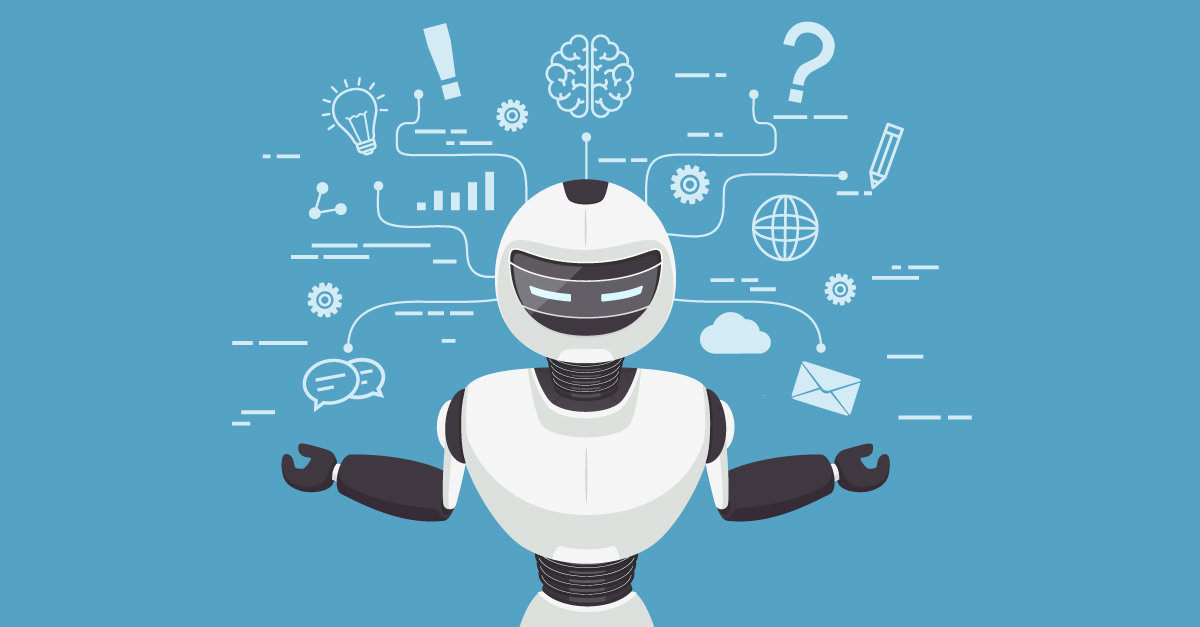
Source: https://sloanreview.mit.edu/wp-content/uploads/2019/02/GEN-Kardon-AI-B2B-Marketing-1200x627-1200x627.jpg
What is Artificial Intelligence?
Artificial intelligence is the science and engineering of making computers behave in ways that, until recently, we thought required human intelligence.
What is Machine Learning?
Machine Learning is a subset of AI, which enables machines to learn from past data or experiences without being explicitly programmed.
The following Infographics by Smart Insights, the creators of the RACE Planning Framework, outlines the various possible applications of AI & ML across the customer lifecycle.
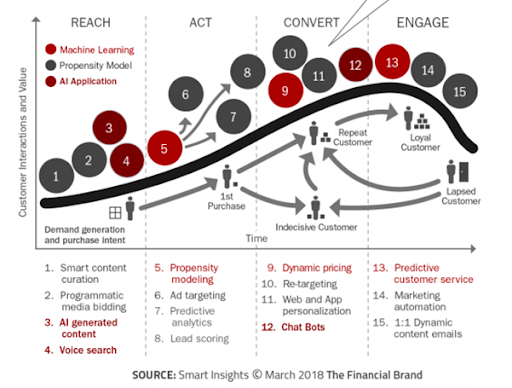
The following are the five areas in which the AI & ML technologies are extensively and actively being used in e-commerce improving marketing and business outcomes.
Generating Customer and Competitor Insights
Collecting and analyzing customer data from various sources allows us to discover insights that help in precisely recommending relevant products or services, thus increasing sales and customer experience. Text-mining customer reviews from e-commerce sites, social media, blogs, and review websites, and applying sentiment analysis algorithms provide a precise perception in which the customers view the products/services. These valuable insights help e-commerce companies in product optimization and filling customer experience gaps. Additionally, this analysis also assists in unearthing upcoming market trends and helps in staying ahead of the competitors.
Customer Segmentation
Customer segmentation is the method of grouping customers of similar characteristics, and it’s one of the cornerstones of effective marketing. Segmentation traditionally was done on the basis of age, gender, and other demographic parameters only. Though this helped marketers in dividing the customers into larger generic groups, it failed to help them understand the customers deeply. Implementing AI/ML in customer segmentation removes these limitations by leveraging customer behavioral data in creating more targeted segments that improve the efficiency of the marketing initiatives. Utilizing AI/ML in segmentation is not only efficient and scalable but also removes the human bias that’s involved in the traditional process.
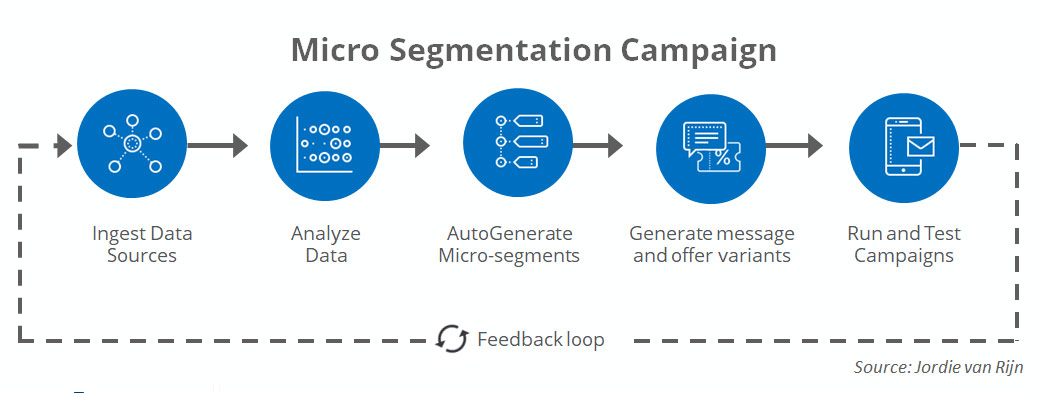
Source: https://thefinancialbrand.com/wp-content/uploads/2019/10/micro-segmentation-flow.jpgngs/2019/02/GEN-Kardon-AI-B2B-Marketing-1200x627-1200x627.jpg
Automated Content Generation
One of the factors that determine the success of the marketing campaign is the content that’s creative, appropriate, and importantly must resonate with the target audience. Yet another challenge in creating compelling content is understanding of the subject matter and industry dynamics. Marketers shall leverage Natural Language Generation and AI technology in overcoming these challenges. AI has evolved to perform keyword research autonomously and deliver content that aligns with the campaign objectives. NLG used along with Natural Language Processing (NLP), enables automated response to reviews and customer queries in e-commerce and social media platforms, thus saving on the resource cause and improving customer engagement.
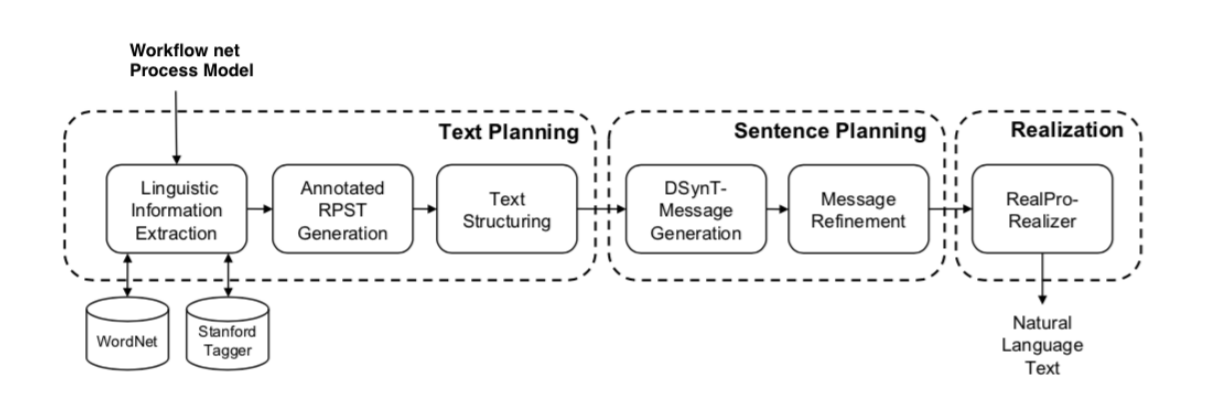
Source: http://ceur-ws.org/Vol-2196/BPM_2018_paper_21.pdf
Campaign Optimization
Reaching out to the right customers with the right content at the right time defines the success of the campaign. Nevertheless, customers also demand hyper-personalized communications and offers that resonate with them. As a result, it has become a mounting challenge for marketers to adjust and optimize their content in real-time. Taking advantage of AI-powered analytical optimization helps marketers meaningfully utilize every penny of the marketing budget in acquiring customers. The AI algorithms are capable of accessing the market, competitors’ SOV and layers the same with campaign objectives in intelligently placing the Ads for better CTR and conversion.
Demand Forecasting
Demand forecasting prevents e-commerce companies from having an excessive amount of goods in stock or out-of-stock. It uses predictive analytics, a statistical technique used in Machine Learning, to precisely forecast customer demand by analyzing historical data. These forecasting insights help e-commerce companies reduce supply chain costs and optimize financial planning, capacity planning, and risk assessment decisions. Marketers shall leverage demand forecasting by incentivizing customers with offers to buy products/services during a low demand period and plan resources during high demand to sustain customer experience. One of the common pitfalls is that it would be hard to predict the demand accurately for new products. However, using data from products of similar categories helps to overcome this challenge.
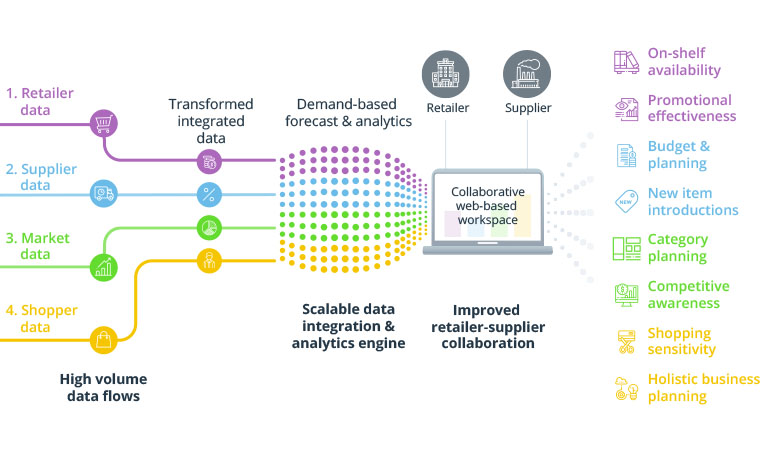
Source: https://d3e3a9wpte0df0.cloudfront.net/wp-content/uploads/2019/11/Fashion-retailers-image-11.jpg
SetuServ’s VOCIS platform employs a state of art AI and ML algorithms specifically modelled for the e-commerce industry that enables text mining from various sources and helps in delivering insights and content recommendations leading to business development.
